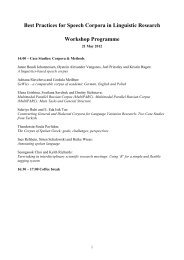96 • 2011 - Hamburger Zentrum für Sprachkorpora - Universität ...
96 • 2011 - Hamburger Zentrum für Sprachkorpora - Universität ...
96 • 2011 - Hamburger Zentrum für Sprachkorpora - Universität ...
You also want an ePaper? Increase the reach of your titles
YUMPU automatically turns print PDFs into web optimized ePapers that Google loves.
in a position to search for the corresponding frame<br />
element configuration of its Spanish translation<br />
equivalent responder. Taking a look at the lexical entry<br />
of responder in Spanish FrameNet we see that the<br />
variation of syntactic realizations of FEs is similar to<br />
that of answer in Table 1.<br />
FE Name Syntactic Realizations<br />
SPEAKER NP.Ext, NP.Dobj, CNI, PP_por.COMP<br />
MESSAGE AVP.AObj, DNI, QUO.DObj,<br />
queSind.DObj, queSind.Ext<br />
ADDRESSEE NP.Ext, NP.IObj, PP_a.IObj, DNI, INI<br />
DEPICTIVE AJP.Comp<br />
MANNER AVP.AObj, PP_de.AObj<br />
MEANS VPndo.AObj<br />
MEDIUM PP_en.AObj<br />
TRIGGER PP_a.PObj, PP_de.PObj, DNI<br />
Table 3: Partial Realization Table for the verb responder<br />
(Boas 2005a)<br />
Spanish FrameNet also offers a valence table that<br />
includes for responder a total of 23 different frame<br />
element configurations. Among these, we find a<br />
combination of FEs and their syntactic realization that is<br />
comparable in structure to that of its English counterpart<br />
in Table 2 above.<br />
Multilingual Resources and Multilingual Applications - Invited Talks<br />
Sp M Tr A<br />
a. NP.Ext QUO.DObj DNI DNI<br />
b. NP.Ext QueSind.DObj DNI DNI<br />
Table 4: Excerpt from the Valence Table for responder<br />
(Boas 2005a)<br />
Comparing Tables 2 and 4 we see that answer and<br />
responder exhibit comparable valence combinations<br />
with the FEs SPEAKER and MESSAGE realized syntactically<br />
while the FEs TRIGGER and ADDRESSEE are not realized<br />
syntactically, but are instead implicitly understood (they<br />
are definite null instantiations). With a Spanish<br />
counterpart in place it now becomes possible to link the<br />
Spanish set of frame element configurations in Table 4<br />
with its English counterpart in Table 2 via the<br />
Communication_Response frame as the following<br />
Figure illustrates.<br />
Figure 2: Linking partial English and Spanish lexicon<br />
fragments via semantic frames (Boas 2005a)<br />
Figure 5 shows how the lexicon fragments of answer<br />
and responder are linked via the Communication_<br />
Response frame. The 'a' index points to the<br />
respective first lines in the valence tables of the two LUs<br />
(cf. Tables 2 and 4) and identifies the two syntactic<br />
frames as being translation equivalents of each other. At<br />
the top of Figure 2 we see the verb answer with one of<br />
its 22 frame element configurations, i.e. SPEAKER,<br />
TRIGGER, MESSAGE, and ADDRESSEE. Figure 2 shows for<br />
this configuration one possible set of syntactic<br />
realizations of these FEs, that given in row (a) in Table 2<br />
above. The 9a designation following answer indicates<br />
that this lexicon fragment is the ninth configuration of<br />
FEs out of a total of 22 frame element configurations<br />
listed in the complete realization table. Of the ninth<br />
frame element configuration 'a' indicates that it is the<br />
first of a list of various possible syntactic realizations of<br />
these FEs (there are a total of four, cf. Table 2 above).<br />
As already pointed out, the FE SPEAKER is realized<br />
syntactically as an external NP, MESSAGE as an object NP,<br />
and both TRIGGER and ADDRESSEE are null instantiated.<br />
13



